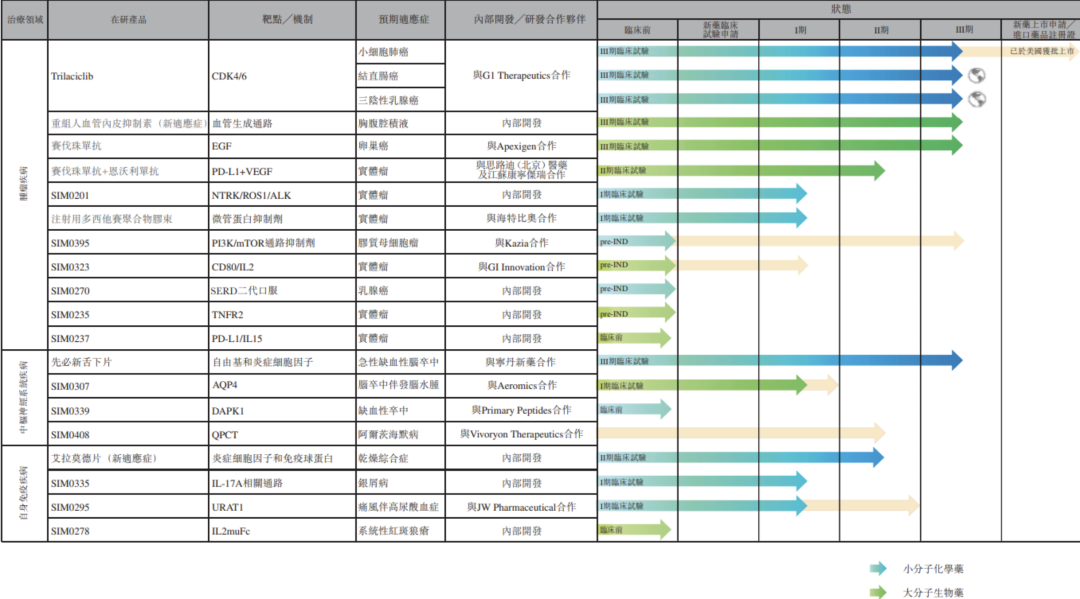预约演示
更新于:2025-09-09

Aeromics, Inc.
更新于:2025-09-09
概览
关联
1
项与 Aeromics, Inc. 相关的临床试验NCT03804476
A Phase 1, Double-Blind, Randomized, Placebo-Controlled, Sequential-Group Study to Assess the Safety, Tolerability, and Pharmacokinetics of Single and Multiple Ascending Doses of AER-271 in Healthy Subjects
The objective of this Phase 1 trial is to assess the safety, tolerability and pharmacokinetics of AER-271 in health subjects.
开始日期2018-06-26 |
申办/合作机构  Aeromics, Inc. Aeromics, Inc. [+1] |
100 项与 Aeromics, Inc. 相关的临床结果
登录后查看更多信息
0 项与 Aeromics, Inc. 相关的专利(医药)
登录后查看更多信息
4
项与 Aeromics, Inc. 相关的文献(医药)2019-04-01·Neuroscience
Functionalized Phenylbenzamides Inhibit Aquaporin-4 Reducing Cerebral Edema and Improving Outcome in Two Models of CNS Injury
Article
作者: LaManna, Joseph C ; Boron, Walter F ; Adams, Amielia G ; Farr, George W ; Hall, Christopher H ; Beahm, Derek L ; McGuirk, Paul R ; Detzel, Joshua M ; Xu, Kui ; Buch, Jasen M ; Farr, Susan M ; Wade, Ramon ; Flask, Christopher A ; Pelletier, Marc F
Cerebral edema in ischemic stroke can lead to increased intracranial pressure, reduced cerebral blood flow and neuronal death. Unfortunately, current therapies for cerebral edema are either ineffective or highly invasive. During the development of cytotoxic and subsequent ionic cerebral edema water enters the brain by moving across an intact blood brain barrier and through aquaporin-4 (AQP4) at astrocyte endfeet. Using AQP4-expressing cells, we screened small molecule libraries for inhibitors that reduce AQP4-mediated water permeability. Additional functional assays were used to validate AQP4 inhibition and identified a promising structural series for medicinal chemistry. These efforts improved potency and revealed a compound we designated AER-270, N-[3,5-bis (trifluoromethyl)phenyl]-5-chloro-2-hydroxybenzamide. AER-270 and a prodrug with enhanced solubility, AER-271 2-{[3,5-Bis(trifluoromethyl) phenyl]carbamoyl}-4-chlorophenyl dihydrogen phosphate, improved neurological outcome and reduced swelling in two models of CNS injury complicated by cerebral edema: water intoxication and ischemic stroke modeled by middle cerebral artery occlusion.
2019-03-01·Pediatric research3区 · 医学
The aquaporin-4 inhibitor AER-271 blocks acute cerebral edema and improves early outcome in a pediatric model of asphyxial cardiac arrest
3区 · 医学
Article
作者: Farr, George W ; Manole, Mioara D ; McGuirk, Paul R ; Alexander, Henry ; Clark, Robert S B ; Janesko-Feldman, Keri ; Jackson, Travis C ; Jha, Ruchira M ; Kline, Anthony E ; Pelletier, Marc F ; Kochanek, Patrick M ; Wallisch, Jessica S
BACKGROUND:
Cerebral edema after cardiac arrest (CA) is associated with increased mortality and unfavorable outcome in children and adults. Aquaporin-4 mediates cerebral water movement and its absence in models of ischemia improves outcome. We investigated early and selective pharmacologic inhibition of aquaporin-4 in a clinically relevant asphyxial CA model in immature rats in a threshold CA insult that produces primarily cytotoxic edema in the absence of blood-brain barrier permeability.
METHODS:
Postnatal day 16-18 Sprague-Dawley rats were studied in our established 9-min asphyxial CA model. Rats were randomized to aquaporin-4 inhibitor (AER-271) vs vehicle treatment, initiated at return of spontaneous circulation. Cerebral edema (% brain water) was the primary outcome with secondary assessments of the Neurologic Deficit Score (NDS), hippocampal neuronal death, and neuroinflammation.
RESULTS:
Treatment with AER-271 ameliorated early cerebral edema measured at 3 h after CA vs vehicle treated rats. This treatment also attenuated early NDS. In contrast to rats treated with vehicle after CA, rats treated with AER-271 did not develop significant neuronal death or neuroinflammation as compared to sham.
CONCLUSION:
Early post-resuscitation aquaporin-4 inhibition blocks the development of early cerebral edema, reduces early neurologic deficit, and blunts neuronal death and neuroinflammation post-CA.
2018-05-01·American journal of transplantation : official journal of the American Society of Transplantation and the American Society of Transplant Surgeons1区 · 医学
Aquaporin 4 blockade improves survival of murine heart allografts subjected to prolonged cold ischemia
1区 · 医学
Article
作者: Farr, George W ; McGuirk, Paul R ; Nicosia, Michael ; Ayasoufi, Katayoun ; Pelletier, Marc F ; Fairchild, Robert L ; Fan, Ran ; Kohei, Naoki ; Valujskikh, Anna
Prolonged cold ischemia storage (CIS) is a leading risk factor for poor transplant outcome. Existing strategies strive to minimize ischemia-reperfusion injury in transplanted organs, yet there is a need for novel approaches to improve outcomes of marginal allografts and expand the pool of donor organs suitable for transplantation. Aquaporins (AQPs) are a family of water channels that facilitate homeostasis, tissue injury, and inflammation. We tested whether inhibition of AQP4 improves the survival of fully MHC-mismatched murine cardiac allografts subjected to 8 hours of CIS. Administration of a small molecule AQP4 inhibitor during donor heart collection and storage and for a short-time posttransplantation improves the viability of donor graft cells, diminishes donor-reactive T cell responses, and extends allograft survival in the absence of other immunosuppression. Furthermore, AQP4 inhibition is synergistic with cytotoxic T lymphocyte-associated antigen 4-Ig in prolonging survival of 8-hour CIS heart allografts. AQP4 blockade markedly reduced T cell proliferation and cytokine production in vitro, suggesting that the improved graft survival is at least in part mediated through direct effects on donor-reactive T cells. These results identify AQPs as a promising target for diminishing donor-specific alloreactivity and improving the survival of high-risk organ transplants.
4
项与 Aeromics, Inc. 相关的新闻(医药)2022-06-13
·药创客
一、溶瘤病毒疗法行业概况1.1 定义溶瘤病毒( oncolytic virus OVs),“溶瘤”即将肿瘤“溶解”(也就是杀死),它是一类新的治疗药物,通过选择性杀伤肿瘤细胞和诱导全身抗肿瘤免疫的双重作用机制实现抗肿瘤效果。溶瘤病毒治疗癌症的基本思路是:将天然或经过基因重组的病毒,选择性地感染癌细胞,通过病毒自身的复制杀死并裂解癌细胞,释放出的病毒继续侵入癌细胞发挥作用。与此同时,癌细胞裂解后释放的肿瘤抗原便能够引起免疫应答反应,引导免疫系统对其他癌细胞甚至远端病灶展开攻击。溶瘤病毒是一个功能分类,并不是一个生物学分类,至今用于溶瘤治疗的病毒高达数十种。根据其是否进行过改造,主要可以分为两类:一类是经过基因重组优先在肿瘤细胞内进行增殖的病毒,主要有单纯疱疹病毒、腺病毒、麻疹病毒以及牛痘病毒等。另一类是野生型病毒株和天然的弱毒病毒株,比如呼肠孤病毒,新城疫病毒和副痘病毒等。图表1 常用溶瘤病毒比较资料来源:生物世界,智银医药资料库与其他肿瘤免疫疗法相比较,溶瘤病毒具有杀伤效率高、靶向性好、不良反应小、多种杀伤肿瘤途径、避免耐药性以及成本低廉等优势。溶瘤病毒可以在不同类型的肿瘤和不同进展阶段的肿瘤,甚至在转移性和无法治愈的癌症中提高总的生存率。对于晚期癌症病人,溶瘤病毒疗法被认为是挽救生命重要的手段之一,而且溶瘤病毒治疗能够诱导达到完全消退或缓解。图表2 适用于肿瘤治疗的几种溶瘤病毒示意图资料来源:Front Med,智银医药资料库1.2 作用原理1.2.1 基本原理2019年美国癌症研究协会(American Association for Cancer Research, AACR)在其年度抗癌报告中将溶瘤病毒归类为继手术、放疗、化疗和靶向治疗后,新的免疫治疗方法。它摒弃了传统手术治疗容易造成患者创口大、易感染,及放射治疗过程中杀敌一千、自损八百的敌我不分和化学药物治疗过程中极易产生耐药性,副作用明显等治疗短板,将个性化靶向治疗方法真正的应用到临床。目前大多数溶瘤病毒的开发都是基于野生型病毒的改造,当然包括应用最大的腺病毒或腺相关病毒的重塑。但无论如何改变,溶瘤病毒对肿瘤细胞的杀伤机制都基本概括为以下三点:(1)溶瘤病毒通过病毒特异性受体介导的机制进入细胞。通常,在肿瘤细胞上高度表达特定的病毒进入受体;另外,还有通过重新靶向溶瘤病毒以通过肿瘤特异性受体进入细胞来改善肿瘤选择性的努力。(2)与正常静止细胞相比,肿瘤细胞具有高代谢和复制活性,快速的细胞分裂增加了病毒复制。此外,肿瘤驱动突变特异性地增加了肿瘤细胞中病毒复制的选择性,且许多肿瘤细胞具有抗病毒I型干扰素信号传导的缺陷,因此支持选择性病毒复制。(3)肿瘤微环境中病毒复制会促使先天免疫和适应性免疫激活,这种激活限制了病毒在正常细胞中的传播。重要的是,病毒的存在以及细胞裂解、肿瘤抗原的释放和危险相关的分子模式,可以克服肿瘤微环境中的免疫抑制并促进抗肿瘤免疫。众所周知,肿瘤不只是一大团癌细胞无规则的聚集在一起,而是一个复杂的系统。里面不仅仅有癌变的细胞,还有很多共生的正常细胞,比如血管细胞,免疫细胞等,正常细胞和癌细胞之间相互作用,相互影响。图表3 溶瘤病毒疗法的发展及作用机制资料来源:生物谷,智银医药资料库1.2.2 “冷肿瘤”与“热肿瘤”免疫细胞是最常见的、与癌细胞共生的正常细胞类型。如果浸润肿瘤组织中的免疫细胞多,那么这个肿瘤就是“热肿瘤(hot tumor)”,反之则是“冷肿瘤(cold tumor)”。大家之所以这么关心癌细胞的冷热,是因为现在很受追捧的“免疫检查点抑制剂疗法”对“热肿瘤”有用,而对“冷肿瘤”基本无效。因为热肿瘤中已经存在免疫细胞,尤其是T淋巴细胞,但是这些T细胞已经被肿瘤细胞结合并束缚,而免疫检查点抑制剂能够解除肿瘤对T细胞的“刹车”效应,这些被释放的T细胞能够迅速动员,快速杀伤肿瘤细胞。而对于“冷肿瘤”来说,免疫细胞很难识别并杀伤,免疫检查点阻断剂也就很难发挥功效。从这一点出发,对于有极少肿瘤浸润性T淋巴细胞(TIL)附着的“冷肿瘤”来讲,通过抗原暴露的方式激活全身免疫,招募高水平的肿瘤浸润性T淋巴细胞包围肿瘤细胞,使“冷肿瘤变热”,无疑是溶瘤病毒最好的抗肿瘤方式。图表4 免疫性冷肿瘤的治疗方式概述图资料来源:Nature Reviews Drug Discovery volume,智银医药资料库1.2.3 表位扩张效应与良好预后在细胞免疫过程中,依据抗原表位刺激机体免疫应答的强弱,可将其分为两类:(1)优势表位(dominant epitope),其具有强免疫原性,在刚开始接触免疫细胞时,可首先激发免疫反应;(2)隐蔽表位(cryptic epitope),其隐藏于抗原大分子内部或密度较低,在后续应答过程中,才可激活免疫细胞。已发现,特定抗原刺激机体后,免疫系统首先针对优势抗原表位产生应答,但往往尚不足以清除该抗原,随着免疫应答过程的持续,机体可相继针对更多抗原表位(包括隐蔽表位)产生应答,而整个免疫反应也随之增大,此现象称为表位扩张(epitope spreading)。良好的预后是临床实验期望的结果。肿瘤组织经溶瘤病毒处理后,能够激发局部的甚至是全身性的免疫反应,进一步攻击肿瘤残存碎片,通过表位扩张现象清除隐藏或发生转移的肿瘤细胞,使患者预后良好,达到不再复发或者恶化转移的目的。当然,表位扩展的过程中更多的需要我们临床医生依据临床表现做出适当的药物或人为干预,以防诱发自身免疫疾病。Kaufman等人于2016年综述了目前已知的溶瘤病毒在人体肿瘤细胞中复制并激活局部及全身免疫反应的分子细节。即溶瘤病毒的治疗功效取决于直接的细胞裂解作用和间接的抗肿瘤免疫反应激活这两者的结合。肿瘤细胞一旦感染溶瘤病毒后会启动由内质网(endoplasmic, ER)应激和遗传毒性应激组成的抗病毒反应。这种反应导致活性氧(reactive oxygen species, ROS)的上调和抗病毒细胞因子产物的启动。ROS和细胞因子,特别是(I型干扰素(type I interferons, IFNs)会从被感染的癌细胞中释放出来并激活抗原递呈细胞antigen presenting cells, APC)、CD8+ T细胞和自然杀伤性(natural killer, NK)细胞等免疫细胞。紧接着,溶瘤病毒积累到一定量后,产生溶瘤效应,释放病毒后代,进一步释放病源相关分子模式,危险相关分子模式信号以及包括新抗原在内的肿瘤相关抗原。其中,释放的病毒后代通过传播继续感染其他肿瘤细胞。图表5 溶瘤病毒诱导局部和全身抗肿瘤免疫资料来源:Nature,智银医药资料库1.3 发展历程实际上,OVs的发现已经有百年历史,大致可分为3个阶段:野生病毒株发现应用阶段(1904-1990年)、基因改造病毒株研发阶段(1991-2000年)和基因插入及联合治疗增效阶段(21世纪)。20世纪早期,不断存在病毒感染的肿瘤患者出现病情缓解或痊愈的案例,这引起了研究人员的好奇,随后便诞生了溶瘤病毒的概念及相关研究。20世纪中后期,研究人员开始使用免疫接种或病毒感染的方式,进行癌症肿瘤治疗并取得一定成效。但由于当时技术有限,临床主要都是采用天然弱病毒株(水痘病毒、麻疹病毒等),这类毒株对肿瘤细胞杀伤能力有限,容易激活宿主免疫系统被清理,还易引发相关的并发症,研究人员难以有效控制病毒病原性。而当时,化疗和放疗又显示出了颠覆性的疗效,使得溶瘤治疗被忽视,研究跌入低估。20世纪晚期,随着病毒学和基因工程技术的不断发展,研究人员能够对病毒基因进行改造,这大大提高了溶瘤病毒在肿瘤治疗方面的效果、特异性和安全性。之后,溶瘤病毒就开启了肿瘤治疗的新纪元。图表6 溶瘤病毒发展历程资料来源:健康界,智银医药资料库进入21世纪,截至2021上半年,全球已有至少四款溶瘤病毒疗法获批上市,分别为rigvir(ECHO-7病毒)、安柯瑞(重组人5型腺病毒)、T-Vec(单纯疱疹病毒),Delytact。1998年美国基于HSV-1再次深度开发为G207试用于恶性神经胶质瘤I期临床试验(Whisenhunt et al 2015),再到2009年日本基于HSV-1开发的第三代溶瘤病毒G47Delta开展针对胶质母细胞瘤的I 期临床试验(Fukuhara et al 2005)。2015年被美国食品药品监督局(U.S. Food and Drug Administration, U.S. FDA)批准美国安进(Amgen)公司上市的基于HSV-1(1型单纯疱疹)病毒基因改造产品 T-VEC(talimogene laherparepvec)(随后被欧盟批准上市),是第一个获批应用于临床的靶向黑色素实体瘤治疗的溶瘤病毒,可明显延长患者的总生存期,这标志着溶瘤病毒治疗已经走向成熟。T-VEC 的开发是基于皮肤和淋巴结有转移性黑色素瘤损伤患者的三期临床试验,通过可致唇疱疹的1型单纯疱疹病毒(HSV-1)共表达免疫激活蛋白粒细胞-巨噬细胞集落刺激因子(GM-CSF)经瘤体内注射,感染肿瘤细胞并在其内复制、裂解癌组织,并激活全身免疫反应的过程,主要用于治疗转移性,经手术无法祛除的黑色素瘤,属第二代HSV-1产品。图表7 已上市溶瘤病毒资料来源:智银医药资料库1.4 溶瘤病毒常见种类溶瘤病毒疗法基于病毒的细胞裂解能力对肿瘤细胞进行杀伤,有多种常用病毒并可通过基因编辑技术进行修饰以提高靶向效率。病毒因其天然的细胞裂解功能,是杀伤肿瘤细胞的有效选择。从最初的天然病毒到经过基因编辑的病毒,溶瘤病毒的种类也从最初的疱疹病毒发展到十多种常用的病毒,其中腺病毒以其基因编辑的简易性和使用的灵活性成为了最为常用的溶瘤病毒。其它常用的病毒包括单纯疱疹病毒、牛痘病毒、新城疫病毒、麻疹病毒、呼肠孤病毒、柯萨奇病毒、脊髓灰质炎病毒等。溶瘤病毒的种类跨越单链到双链,从RNA到DNA,从天然到基因编辑,极大地提升了该疗法的在实体瘤临床治疗中的灵活性。图表8 主要的溶瘤病毒对比资料来源:Oncoimmunology,智银医药资料库1.5 溶瘤病毒疗法与其它肿瘤疗法对比溶瘤病毒疗法由于病毒独特的生物特性,对于实体瘤疗效显著,总体副作用较低,价格较其它创新疗法低,为肿瘤患者提供了新的治疗选择。传统肿瘤疗法包括手术切除、化疗、放疗,对早期肿瘤具有较强的杀伤力,患者预期良好,但是对于中晚期患者通常疗效不佳,加之传统疗法的高侵入性和影响广泛的不良反应,该类疗法在中晚期患者治疗中的地位逐渐被新型免疫疗法所替代。新型疗法涵盖了几个大类包括肿瘤免疫抗体药物、细胞基因治疗、溶瘤病毒疗法等。溶瘤病毒疗法的研究开发长期集中在实体瘤适应症,得益于其独特的生物特性,该疗法在实体瘤治疗上有着独特的优势。在建立符合临床要求的安全性和有效性的基础上,溶瘤病毒疗法未来可能深入不同的血液瘤适应症,为广大患者提供新的治疗选择。图表9 OV优劣势分析对比资料来源:智银医药资料库1.6 产业链溶瘤病毒药物行业产业链的上游市场参与者为原材料、仪器设备提供商,以及CMO/CDMO企业;中游环节主体为各类药物研发机构,包括医药公司和科研院所与研发团队,下游涉及肿瘤医疗服务机构以及肿瘤患者。图表10 中国溶瘤病毒药物行业产业链资料来源:观研天下,智银医药资料库产业链上游分析溶瘤病毒药物研发的上游主要参与者包括原材料、仪器设备提供商以及CMO/CDMO企业。溶瘤病毒药物大多处于临床试验阶段,仅有T-VEC、安柯瑞实现商业化生产。在溶瘤病毒药物新药研发过程中,原材料、仪器设备等成本不足30%,主要成本来源于临床试验,尤其III期临床开发成本巨大,通常,每个病人平均花费为100万元人民币,新药研发对企业技术实力与资金实力提出双重考验。CMO/CDMO企业可负担研发环节的生产任务,使溶瘤病毒药物研发企业专注于研发环节,进一步提高新药研发效率。在新药研发的不同阶段,CMO/CDMO承担不同等级的生产任务,实验室CMO/CDMO业务集中于药物发现和临床前开发阶段,工厂CMO/CDMO聚焦于临床研究和商业化生产。中国CMO/CDMO行业企业集中程度低,市场竞争程度高。病毒载体领域的CMO/CDMO企业主要有和元上海、五加和、赛诺生等。图表11 病毒载体领域CMO/CDMO企业举例资料来源:广证恒生,智银医药资料库产业链中游分析中国溶瘤病毒药物行业中游涉及各类药物研发机构,安进公司研发的T-VEC是首个被全球认可的溶瘤病毒药物。尽管溶瘤病毒药物的临床研究进展不断深入,如何提高肿瘤靶向性、选择和优化载体细胞、药物安全性、抗体中和作用以及病毒扩散等技术难点仍待解决。尽管溶瘤病毒药物的研发存在技术难点,但在杀伤肿瘤细胞方面其具备明显优势,前景广阔。国际巨头纷纷通过并购或合作布局溶瘤病毒药物研发。图表12 溶瘤病毒技术难点资料来源:浙江证券,智银医药资料库产业链下游分析伴随老龄化的加深、居民生活环境与生活习惯的改变,中国癌症发病人数逐年增加,导致对肿瘤治疗需求迫切,医院肿瘤医疗服务收入快速增长。按地域市场统计,三线及其他城市占中国医院肿瘤医疗服务收入最大比例。三线及其他城市肿瘤医疗服务收入由2014年的1,136亿元人民币增长至2019年的2,128亿元人民币,年复合增长率为12.5%。预计未来五年,三线及其他城市肿瘤医疗服务收入将继续以13.4%的年复合增长率保持增长,2024年,服务收入将达到3,831亿元。现阶段,中国肿瘤医疗服务市场仍存在筛查、治疗渗透率低的问题,存在巨大发展潜力,预计整体肿瘤医疗服务收入未来五年复合增长率为11.9%,2024年,收入规模达6,543亿元人民币,整体肿瘤医疗服务市场的增长必将带来溶瘤病毒药物销量的增长。 图表13 2014-2019年中国各线城市医院肿瘤医疗服务收入资料来源:华经产业研究院,智银医药资料库二、全球行业市场情况2.1 抗肿瘤药物市场2.1.1 全球发病人数肿瘤已成为危害人类健康最严重的疾病之一,发病人数持续增加,死亡率高,当前传统肿瘤治疗手段仍存在许多未被满足的临床需求,溶瘤病毒疗法提供了新的治疗方式。2020年,全球恶性肿瘤总发病人数达到1,929万人,随着人口老龄化、不良生活习惯以及社会环境因素的影响,预计肿瘤发病人数将持续增加,2025年发病人数将达到2,162万,2020至2025年复合年增长率为2.3%。溶瘤病毒作为一种新型肿瘤免疫疗法,通过直接裂解肿瘤细胞或者抗肿瘤免疫反应达到杀伤肿瘤细胞的目的,而不影响正常细胞的生长,为广大恶性肿瘤患者带来希望。图表14 全球与中国肿瘤发病与死亡人数资料来源:沙利文,智银医药资料库2.1.2 抗肿瘤药物市场规模全球及中国抗肿瘤药物市场近年来持续增长,随着肿瘤患者的增加以及肿瘤治疗技术不断创新,预计全球及中国抗肿瘤药物市场将进一步扩大。受到全球癌症人口的增长以及前沿癌症治疗方法兴起的共同影响,全球肿瘤药物市场规模持续增长。截至2020年底,全球抗肿瘤药物市场规模为159.3亿美元,较上年增加15.8亿美元,同比增长11.01%;预计2021年全球抗肿瘤药物市场规模将达到177.9亿美元。图表15 全球与中国抗肿瘤药物市场规模资料来源:智研咨询,智银医药资料库2020年,全球肿瘤药物市场以靶向药物为主,占比为60.4%,化疗及肿瘤辅助用药占比较低,肿瘤免疫治疗占比为23.4%。随着技术不断创新,肿瘤免疫治疗市场占比将扩大,2030年预计占比达到47.6%。图表16 全球抗肿瘤药物市场拆分资料来源:沙利文,智银医药资料库2.2 溶瘤病毒市场全球及溶瘤病毒行业市场规模在技术创新、政策利好及研发投入增长的背景下将快速扩增。2016年至2020年,全球溶瘤病毒市场增长较缓。随着技术创新,更多溶瘤病毒产品商业化,预测未来溶瘤病毒市场规模有快速增长趋势,预计于2025年全球整体市场规模达到67.9亿美元,2020到2025年(估计)全球溶瘤病毒市场复合年增长率为171.2%。图表17 全球及中国溶瘤病毒市场规模资料来源:沙利文,智银医药资料库三、国内行业市场情况3.1 肿瘤方面3.1.1 中国发病人数2020年,中国恶性肿瘤总发病人数约为457万人,预计未来肿瘤发病人数将不断增加,2025年将达到520万,2020至2025年复合增长率为2.6%。2020年,中国恶性肿瘤死亡人数约271万人,预计2025年达到312万人。在患者增加以及肿瘤领域大量未被满足的临床需求推动下,溶瘤病毒疗法市场将不断扩大。图表18 中国肿瘤发病与死亡人数资料来源:《2018年全球癌症统计报告》,智银医药资料库3.1.2 抗肿瘤药物市场规模肿瘤治疗技术的不断创新使得中国肿瘤治疗市场未来几年也处于上升态势。预计中国抗肿瘤药物市场在2025年将会达到603亿美元,年复合增长率为16.1%。图表19 中国抗肿瘤药物市场规模资料来源:智研咨询,智银医药资料库目前,中国抗肿瘤药物市场中化疗及辅助用药占主导,达到总市场的63.4%。靶向药物占29.1%的比例,7.5%为肿瘤免疫治疗,滞后于全球市场。随着政策及监管体系的完善、技术不断成熟和患者负担能力提高,中国抗肿瘤药物市场将快速发展,预计2030年肿瘤免疫治疗将占据市场的39.9%,体现出未来肿瘤免疫治疗市场的巨大潜力。图表20 中国抗肿瘤药物市场拆分资料来源:沙利文,智银医药资料库3.2 溶瘤病毒方面2016年至2019年,中国溶瘤病毒市场从2.7亿元增长到6.7亿元,复合年增长率为11.1%。预测未来中国溶瘤病毒市场规模快速增长,中国溶瘤病毒药物市场规模将以16.2%的年复合增长率继续保持增长,到2024年,市场规模有望上升至14.3亿元。图表21 中国溶瘤病毒市场规模资料来源:头豹研究院,智银医药资料库3.3 市场驱动力分析3.3.1 医药市场规模分析中国是全球第二大医药市场,预计到2025年,中国医药市场规模将达到3,315亿美元,在全球市场份额的比重也将上升到19.4%。同期的中国复合年均增长率为9.6%,将超过全球复合年均增长率(5.7%)。预计2020年至2025年,中国医药市场的复合年均增长率将高于全球其他地区。受到政策红利、大量的研发投入、人口红利等影响,未来中国医药市场占全球医药市场份额将持续上升,为溶瘤病毒产业发展带来充足的市场空间。图表22 全球及中国医药市场资料来源:沙利文,智银医药资料库3.3.2 研发投入分析由于患者需求的增长、相关政策的支持以及创新技术的推出,中国医药研发投入增速加快,将推动溶瘤病毒行业发展。中国医药研发开支占营收比低于同期水平2019年全球医药研发开支占营收比为13.8%,而中国市场占比仅为8.9%。随着政策和人才红利的推动,预计未来中国制药企业将加大创新药物研发开支,溶瘤病毒行业具有较大市场潜力与增长空间。中国医药研发开支具有较大增长潜力,利于溶瘤病毒产业快速发展2020年,中国医药研发开支为247亿美元,占全球总开支的12.1%。预计到2025年,中国医药研发开支将达到496亿美元,占全球医药开支比重的16.8%。同期复合年增长率为15.0%,为全球医药研发开支复合年均增长率的近2倍。在利好政策背景下,研发开支的增长将推动溶瘤病毒的技术创新与临床转化,促进溶瘤病毒产业快速发展。图表23 全球及中国医药研发开支资料来源:沙利文,智银医药资料库3.3.3 投融资分析受政策、资金、人才支持,中国医药市场受资本市场的青睐。基因治疗包括OV行业成为中国资本投资热点,给予OV产业发展资金支持。中国医药市场受资本市场青睐,预计未来资本投资仍会保持上升趋势但趋于理性在2015年,中国医药市场投资金额为32亿美元,占全球投资额16.3%。到2019年,中国医药市场资本投资金额为50亿美元,同期全球市场为407亿美元,占比为12.3%。预计未来,中国和全球医药产业投资规模仍会增加。医药投融资市场活跃,基因治疗包括OV领域热度升温据中国基因治疗领域融资交易情况显示,2020年度基因治疗领域融资总金额约为101亿美元,2016年至2020年复合年增长率达到72.1%。2020年IPO和私募基金的金额显著增加。预计未来整个医药投融资市场仍会保持较高活跃度,基因治疗领域的资本投入不断增加,资本注入也将推动OV产业发展。但同时溶瘤病毒药物行业面临科研投入风险、给药技术制约风险、政策性风险、病毒复制受限风险,以及技术替代风险等行业风险。图表24 溶瘤病毒药物行业风险资料来源:头豹研究院,智银医药资料库3.3.4 CXO分析OV相比传统药物研发投入多且研发生产难度较高,CRO/CDMO服务覆盖病毒构建及优化、规模化放大,纯化包装等OV研发生产流程中各阶段,推动OV产业快速发展。OV研发生产费用及难度较传统药物更高,CXO帮助企业控制成本OV在研发生产各个阶段的费用均超过传统药物,促使企业与成熟的CXO合作以期控制成本投入。近年来,兴起了一批拥有自主知识产权和核心技术的医药创新研发团队。然而,这类小型或初创企业往往不具备生产所需的设施,缺乏生产相关的经验,其通常需要与CDMO公司合作完成项目的研究和开发。OV作为研发投入和难度较高的创新疗法,CXO通过成熟的生产工艺及设备提供病毒放大生产等服务,帮助企业控制成本,推动OV产业发展。CDMO在市场中有产能和利润方面的优势CDMO公司的基本价值是依托医药研发精细化、专业化分工,解决药物生产所需资质和厂房问题,并帮助医药公司降低生产成本,提高生产效率。随着全球医药市场的持续增长以及药物研发难度增大、IRR逐年降低,医药公司的研发模式由内部全产业链研发转向将化合物合成和筛选、药代药理评价、原料药和制剂的工艺研发和生产等相对非核心业务外包。CDMO利用成熟的生产工艺和平台在控制成本的同时,加快OV的研发生产,帮助企业快速抢占市场份额,取得更大利润。图表25 OV与传统药物研发对比及主要相关CXO资料来源:Emergen Research,智银医药资料库四、OV已上市产品及临床试验产品全球已获批OV及临床试验集中在实体瘤领域,现有4款OV产品获批上市,随着技术创新、适应症拓展及临床试验的推进,未来OV市场增长空间巨大。全球共获批4款OV产品,市场空间巨大全球最早获批的溶瘤病毒产品是拉脱维亚SIA Latima/RIGVIR Group公司研发的Rigvir,用于治疗黑色素瘤。之后,中国上海三维生物研发的安科瑞成为全球第二款获批溶瘤病毒产品。近年来,溶瘤病毒获批产品较少,未来市场发展空间巨大。图表26 全球已获批OV产品 资料来源:Emergen Research,智银全球生物医药库全球溶瘤病毒临床试验集中在实体瘤,联合疗法较多,病毒种类多样化近年来,由于溶瘤病毒针对实体瘤的显著疗效、靶向性等独特优势,众多生物技术企业开始布局溶瘤病毒疗法。其与传统疗法或免疫抑制剂的协同效应明显,联合疗法在临床试验中较多。病毒种类也呈现多样化,临床应用中除腺病毒及疱疹病毒外,还包括呼肠孤病毒、牛痘病毒、脊髓灰质炎病毒等。给药途径主要为瘤内注射,其它给药途径包括静脉注射、腹腔内注射等也在探索中。目前全球走在前列的临床OV产品均已逐步进入三期,其中以Oncolytics Biotech和Candel Therapeutics的为主。其中Oncolytics Biotech是最有希望上市的产品,如若三期临床顺利,最早可在2024年上市。同时我们也注意到一些国内开发OV的厂商也进入大众视野。图表27 全球及中国领先的OV临床试验资料来源:沙利文,智银全球生物医药库4.1 安科瑞鼻咽癌是多发于亚洲的恶性肿瘤,传统疗法对于中晚期及复发患者预后不理想,OV的上市为这类患者带来了创新疗法鼻咽癌简介鼻咽癌是多发于鼻咽腔或上咽喉部的实体瘤,是全球最为常见的头颈部肿瘤之一,全球发病率约为1/10万人。在亚洲某些地区和中国南部的广东省和香港,该肿瘤最为常见,发病率可达80~100/10万人,因此现阶段主流意见认为该肿瘤和遗传有较大关联。除了遗传外,EB病毒感染、不良饮食习惯都是其危险因素。鼻咽癌诊疗和未被满足的临床需求鼻咽癌的诊断通常包括临床表现、活体检验和影像诊断。鼻咽癌大多数情况下不适合手术切除,早期根治依赖全身或局部放疗,配合后期化疗等治疗手段5年生存率超80%,是预期较好的实体瘤之一。中晚期患者和复发患者因为分型复杂和转移率高,即使联合化疗或EGFR单抗,疗效差异性也较大,总体预期不理想、总体生存率较低,而溶瘤病毒为这类患者提供了新疗法。安科瑞简介安科瑞是由上海三维生物开发的一款针对无法切除或复发转移的鼻咽癌的溶瘤病毒,于2005年被NMPA批准在中国上市,是全球第二款上市的溶瘤病毒产品,单剂售价接近3000元人民币。安科瑞2004年3期临床试验结果显示其客观有效率较一线化疗疗法提升较大(72.7% vs. 42.4%),为后来多款OV的研发提供了许多可借鉴之处。但是由于该产品对正常细胞也具有杀伤力,导致该疗法总使用率不高,未进入诊疗指南所推荐的一线和二线治疗。安科瑞治疗原理安科瑞是一款基于腺病毒的注射型基因药物,通过基因工程的手段研究人员敲除了腺病毒中能够阻止细胞死亡的E1b蛋白。在引起局部炎症后,E1b蛋白的敲除加速腺病毒对于被感染细胞的裂解并加速导致癌细胞的死亡。细胞死亡后释放大量抗原以引起周边CD4+、CD8+T细胞的免疫反应,继而对肿瘤细胞起到破坏的作用,形成了一个消灭癌细胞的正循环,一次或少次用药即可达到长期疗效。图表28 安科瑞治疗复发鼻咽癌的原理资料来源:三维生物官网,智银全球生物医药库4.2 Imlygic黑色素瘤是全球最为常见的实体瘤,也是发展中国家致死率最高的肿瘤之一,OV的发展为其开拓了治疗路径。黑色素瘤简介黑色素瘤是由人体表皮黑色素细胞异常增殖而来,是最为常见的恶性实体瘤之一,全球每年约有33万新增患者,多发于欧洲、北美和大洋洲。我国每年新增约2万名新增患者,但因早期筛查不足,大多患者为中晚期,5年综合生存率不足50%,远远低于美国的93%。黑色素瘤的主要诱因为紫外辐射,患者通常长期无保护的在日照下工作或使用美黑机。黑色素瘤诊疗和未被满足的临床需求黑色素瘤的诊断通常是组织活体检查。黑色素瘤与其他实体瘤在治疗路径上相似,因为直接化疗效果甚微,绝大多数早中期患者会选择手术切除,术后辅助治疗包括化疗和含抗PD-1或抗CTLA-4的抑制剂的免疫疗法。早期患者术后预期较好,中晚期患者手术风险大、疗效不理想、总体生存率较低,存在复发后面临无药可用或治疗效果欠佳的问题。这也体现出对于中晚期患者治疗手段的缺乏,而溶瘤病毒疗法为这类患者提供了治疗选择。Imlygic简介Imlygic是由安进开发的一款针对局部不可切除的黑色素瘤的溶瘤病毒产品,于2015年10月被FDA批准在美国上市。单次价格约为6.5万美金。患者仅需使用几次或至黑色素瘤完全消失,不需长期用药。但是由于美国黑色素瘤筛查早、总体预期极好,上市后Imlygic销量一直不佳,再加上关键专利将在未来1-3年过期,未来预期类似药会在需求更大的中国和印度市场发挥其可代替手术的作用。Imlygic 治疗原理Imlygic是一个基于单纯疱疹病毒的注射型基因药物,它能够引起局部炎症,导致癌细胞的死亡。同时它所表达的人类GM-CSF蛋白能够有效的聚集树突状细胞,从而增加抗原展示,以引起周边CD4+、CD8+T细胞的免疫反应,继而对肿瘤细胞起到破坏的作用,形成了一个消灭癌细胞的正循环,达到一次或少次用药即治愈的效果。 图表29 Imlygic治疗复发黑色素瘤的原理资料来源:Amgen官网,智银全球生物医药库4.3 Delytact神经胶质瘤是死亡率最高的肿瘤之一,患者通常局限于手术治疗,OV疗法为中晚期患者带来了希望。神经胶质瘤简介神经胶质瘤是死亡率最高的肿瘤之一,是一种最为常见的中枢神经系统肿瘤,其特点为分型众多,治疗困难,多发于白人,亚洲人和非洲人群中发病率则较为低。神经胶质瘤发病和多种原因相关包括肿瘤起源、家族遗传、病毒感染、生化环境、不良饮食习惯以及电磁辐射等。神经胶质瘤诊疗和未被满足的临床需求神经胶质瘤的诊断通常依靠神经影像学检查,神经胶质瘤主要治疗手段为手术切除,但是手术风险较大,特别是位于控制运动和语言脑叶的肿瘤,切除不当会导致患者的终身残疾,如果切除不完全则可能需要二次开颅手术。其次术后颅内压力可能会升高,需做分流术。除了手术切除外,放射治疗和化疗也可作为次要治疗手段,但是放疗疗效根据分型不同差异性大,神经胶质瘤的化疗则需要考虑血脑屏障,极大的限制了可使用的化药类型,体现患者治疗选择的局限性,因此众多药企都对该适应症做出创新疗法布局。Delytact简介Delytact是由日本第一三共和东京大学联合开发的一款针对神经胶质瘤的溶瘤病毒产品,于2021年被日本厚生劳动省批准上市,成为全球首款针对脑部肿瘤的溶瘤病毒产品,产品售价将由厚生劳动省审查决定。根据其2期临床中期结果显示,13例神经胶质瘤患者的1年生存率达到92.3%,仅有两名患者有严重不良反应,均为2级发热。Delytact也已开展多项针对其他适应症及联合其他疗法的临床试验,展现出与CTLA-4抑制剂和射频消融等的协同作用,在胃癌、前列腺癌及肝癌等疾病都表现出有效的肿瘤杀伤能力,未来有望扩展适应症,并与其他疗法联合用于肿瘤治疗。Delytact治疗原理Delytact是一款基于第三代单纯疱疹病毒的注射型基因药物,通过基因工程的手段研究人员敲除了γ34.5、ICP6、α47基因,这些敲除减弱了病毒性、加强了靶向性、增强了病毒复制率,对溶瘤病毒的功能性和安全性有了飞跃性的提高。图表30 Delytact治疗神经胶质瘤的原理资料来源:Daiichi Sankyo Company,智银全球生物医药库五、国内外主要OV公司及相关产业国外OV公司1. Oncolytics BiotechOncolytics Biotech始创于1998年,是研究溶瘤病毒疗法的早期公司之一,公司的主要产品为pelareorep, 是基于呼肠孤病毒的溶瘤病毒疗法,早期该药物运用于头颈部鳞状细胞癌的临床试验中,现阶段临床研究适应症集中在乳腺癌,同时也展开了与阿诺制药在亚洲的合作开发,也在消化道肿瘤和多发性骨髓瘤等疾病领域进行了布局,是未来最有希望被批准的产品之一。创始人(Coffey)公司的联合创始人,Coffey 博士在卡尔加里大学完成了肿瘤学博士学位,重点研究呼肠孤病毒的溶瘤能力。他的研究成果已发表在各种受人尊敬的科学期刊上,包括 Science、Human Gene Therapy 和 The EMBO Journal。Coffey 博士于 2016 年底接任首席执行官,在此之前,他自 2008 年 12 月起担任首席运营官。自共同创立 Oncolytics 以来,他还2004年12月至2008年12月担任首席科学官、副总裁1999 年7月至2004年12月担任产品开发总监,1999 年9月至2000年5月担任首席财务官。产品管线目前公司的管线均针对pelareorep开发的联合疗法。 图表31 Oncolytics Biotech主要管线资料来源:Oncolytics Biotech,智银全球生物医药库临床研究计划临床开发计划基于 pelareorep 的广泛适用性,以提高一系列免疫疗法的有效性——立即关注检查点抑制剂——跨越多种癌症适应症。主要目标是尽快获得 pelareorep 的监管批准,并基于优良的转移性乳腺癌生存数据、与检查点批准的抑制剂和生物标志物的协同作用。第二个目标是与制药合作伙伴合作,将 pelareorep 扩展到具有商业价值的新治疗领域,包括其他免疫治疗药物。公司与辉瑞(Pfizer)、默克(Merck KGaA)、默克(Merck)、百时美施贵宝(Bristol-Myers Squibb)、罗氏(Roche)和因赛特(Incyte)合作开发他们的检查点抑制剂,并开发项目来评估针对转移性乳腺癌的临床研究的有效性和安全性,早期分期乳腺癌、多发性骨髓瘤和胃肠道癌,包括胰腺癌、结肠直肠癌和肛门癌。最终在其他适应症中使用其他免疫疗法的潜力很大,这只会推动 pelareorep 治疗的潜力。技术路线Pelareorep 是一种天然存在的 非致病 性双链 RNA (dsRNA) 病毒的专有分离物,这种病毒通常在环境水域中发现,称为呼肠孤病毒。它正在开发为一流的静脉内递送免疫治疗剂,用于治疗实体瘤和血液系统恶性肿瘤。它激活先天和适应性免疫系统并削弱肿瘤防御机制。这提高了免疫系统对抗癌症的能力,使肿瘤更容易受到广泛的肿瘤治疗。Pelareorep 激活先天和适应性免疫系统并削弱肿瘤防御机制。这提高了免疫系统对抗癌症的能力,使肿瘤更容易受到广泛的肿瘤治疗。Pelareorep 已证明与免疫检查点抑制剂具有协同作用,也可能与其他已批准的肿瘤治疗具有协同作用,包括 CAR T 疗法、双特异性抗体以及 CDK4/6 和 PARP 抑制剂。目前正在开展和计划临床试验,以评估 pelareorep 与检查点抑制剂和靶向治疗在实体和血液恶性肿瘤中的结合,因为它正在向转移性乳腺癌的注册研究迈进。由于癌细胞特有的许多因素,Pelareorep 能够在癌细胞中选择性复制,但不能在正常细胞中复制,包括:细胞信号通路缺陷;高水平的基因组突变(或关键肿瘤抑制基因和癌基因的突变);来自化学和放射治疗的细胞应激Pelareorep 通过激活先天和适应性免疫系统,将免疫无反应的“冷肿瘤”转化为免疫反应的“热肿瘤”,增强人体的天然抗癌免疫反应。感染 pelareorep 的癌细胞会释放炎性细胞因子。这种炎症环境激活自然杀伤 (NK) 细胞并促进 NK 细胞、树突状细胞和T细胞迁移到有助于免疫细胞介导的癌细胞死亡的肿瘤微环境。在 pelareorep 介导的癌细胞死亡后,肿瘤和病毒相关抗原的释放被抗原呈递细胞 (APC) 吸收。然后 APC 处理抗原并将其呈递给T细胞。这训练适应性免疫系统识别和杀死癌细胞。适应性免疫反应允许:消除现有的癌细胞、持续的癌细胞监测、预防复发和提高总体存活率。图表32 Oncolytics Biotech溶瘤病毒技术原理示意图资料来源:Oncolytics Biotech,智银全球生物医药库2. Candel TherapeuticsCandel Therapeutics成立于1999年,是一家专注于OV研发的美国公司,基于病毒的平台,针对我们所针对的每种癌症校准我们的治疗方法。这些病毒经过基因工程改造,可最大限度地减少对健康组织的影响,同时最大限度地提高患者对抗肿瘤的免疫反应。总裁兼CEO(Paul Peter Tak)Paul Peter Tak 博士自 2020 年 9 月起担任 Candel 的总裁兼首席执行官。他以优异的成绩获得了阿姆斯特丹自由大学的医学学位,并在莱顿大学医学中心接受了内科医生、风湿病学家和免疫学家的培训,并在那里获得了他的博士学位。他一直是加州大学圣地亚哥分校的临床医学副教授。接下来,他担任阿姆斯特丹大学 (AMC) 学术医学中心 (AMC) 的医学教授和临床免疫学和风湿病学系的创始主席。在此期间,他创立了专注于基因治疗的生物技术公司 Arthrogen bv。他在同行评审期刊上发表了大量文章(> 570 篇出版物,H-index 130,> 75,000 次引用)并获得了无数奖项。他被选为英国医学科学院院士。在葛兰素史克,他担任高级副总裁、首席免疫官和全球发展负责人。作为治疗领域集群的全球负责人,他监督创建了一系列针对癌症、免疫介导的炎症性疾病和传染病的新疗法,包括 belantamab mafodotin (Blenrep ® )、NY-ESO1 SPEAR T 细胞疗法、STING胞质 DNA 通路激动剂、Benlysta ® sc(和 Benlysta/Rituxan 联合疗法)、otilimab、抗 CCL17 抗体、抗 OSM 抗体、RIP1 激酶抑制剂、cabotegravir/rilpivirine (Cabenuva ® ) 和 gepotidacin。他还是科学审查委员会的主席,该委员会负责对葛兰素史克的研发组合进行科学评估。在 2018-2020 年期间,Tak 博士担任 Flagship Pioneering 的风险合伙人以及 Kintai Therapeutics 的总裁兼首席执行官,这是一家专注于肠道信号网络的初创公司,在那里他监督了免疫肿瘤学小分子发现组合的创建、代谢疾病和神经系统疾病。此外,他还担任过 Tempero Pharmaceuticals 的总裁兼首席执行官,以及 Galvani Bioelectronics、ViiV Healthcare、Sitryx Therapeutics(联合创始人)、Omega Therapeutics、Levicept 和 Citryll 的董事会成员。产品管线公司主要产品是基于腺病毒的CAN-2409和疱疹病毒的CAN-3110,适应症包括前列腺癌、脑癌、肺癌、胰腺癌等。其中最为突出的是正在进行的CAN-2409针对膀胱癌的三期临床试验,在不远的将来有望成为集中上市OV中的一员。图表33 Candel Therapeutics主要管线资料来源:Candel Therapeutics官网,智银全球生物医药库临床研究进展前列腺癌CAN-2409 的随机对照 2 期临床试验,随后是伐昔洛韦对接受局部前列腺癌主动监测的患者:ULYSSES 试验 (PrTK04)。超过 50% 的前列腺癌患者在疾病早期被诊断为低级别、低体积、无症状的疾病。主动监测 (AS) 是一种通过常规前列腺特异性抗原 (PSA) 和基于活检的疾病状态监测来管理患者的方法。这种方法旨在推迟根治性治疗,然而,在诊断后 10 年内,21% 至 38% 的男性将患上进行性癌症并需要侵入性治疗。使用 CAN-2409 的溶瘤病毒免疫疗法可以为这些患者提供低风险的局部干预,并有机会在无需手术或放疗的情况下延迟或预防疾病进展。主要结果测量:无病生存已经完成了一项针对选择主动监测的局部前列腺癌患者的 187 名患者的 2 期研究——我们将这一行动过程称为“主动监测”。脑癌已经完成了 CAN-2409 的 2 期临床试验,随后将伐昔洛韦作为辅助溶瘤病毒免疫疗法用于新诊断的恶性胶质瘤患者的手术切除。在全切除术后,有微小残留病灶的患者的生存结局得到显着改善。Candel 正在利用基于病毒的平台与护理标准相结合,为这一患者群体提供潜在的治疗选择。CAN-3110 (rQNestin) 用于复发性恶性胶质母细胞瘤的开放标签 1 期临床试验胰腺癌已经完成了一项 1 期临床试验,表明使用 CAN-2409 继以伐昔洛韦的溶瘤病毒免疫疗法可以安全地与胰腺癌标准治疗相结合,而不会增加毒性。临床反应和存活率似乎与预期结果相比较,并证明 CD8 阳性 T 细胞浸润增加。CAN-2409的随机2期临床试验,随后是伐昔洛韦联合标准治疗晚期非转移性胰腺癌(PaTK02)。肺癌在适合手术的非小细胞肺癌 (NSCLC) 患者中完成了一项 1 期临床试验。该试验表明,在肺部肿瘤中通过支气管镜瘤内递送 CAN-2409,然后进行伐昔洛韦治疗的溶瘤病毒免疫治疗是一种可行且耐受性良好的方法,可导致肿瘤和外周血中有效的 CD8 阳性 T 细胞活化。III/IV 期NSCLC的标准护理治疗包括免疫检查点抑制剂,但只有约 15-40% 的患者有反应。在临床前研究中,CAN-2409 已证明与免疫检查点抑制剂具有协同作用。基于这些结果和1期临床试验数据,设计了一项2期临床试验,以评估在 III/IV 期 NSCLC 中联合使用 CAN-2409 和伐昔洛韦与免疫检查点抑制剂的溶瘤病毒免疫疗法的安全性和有效性。技术路线CAN-2409(国际非专利名称:aglatimagene besadenovec)是一种基于腺病毒的复制缺陷工程基因构建体,编码源自单纯疱疹病毒的胸苷激酶基因。它直接注射到肿瘤或目标组织中。局部注射旨在最大限度地减少与全身静脉给药相关的全身毒性,消除对复杂免疫逃避或肿瘤特异性靶向机制的需求,并将免疫反应集中在局部对抗肿瘤,同时激活所需的全身抗肿瘤反应。腺病毒构建体用作将胸苷激酶基因转运到注射部位的肿瘤细胞中的载体。胸苷激酶将 FDA 批准的通用抗疱疹药物(例如用作前药的更昔洛韦、阿昔洛韦和伐昔洛韦)转化为有毒的核苷酸类似物。这些药物可广泛获得、价格低廉且通常耐受性良好。用胸苷激酶基因转导的细胞在暴露于这些全身给药的前药后经历免疫原性细胞死亡。前体药物衍生的细胞毒性核苷酸类似物旨在抑制 DNA 复制和修复,导致增殖的肿瘤细胞死亡,特别是正在经历放射或化学损伤修复的细胞死亡。这种溶瘤活性具有免疫原性并暴露出可引发进一步肿瘤特异性免疫反应的肿瘤抗原。此外,病毒本身会刺激显着的免疫反应。图表34 Candel Therapeutics技术路线示意图资料来源:Candel Therapeutics官网,智银全球生物医药库3. Genelux创始人(Tom~Zindrick)Tom~Zindrick 先生一直在董事会任职,自 2014 年以来一直担任总裁兼首席执行官,同时也是 V2ACT Therapeutics LLC 的董事会成员。Tom 是一位成就卓著的高级管理人员,在生命科学公司拥有丰富的经验。从 1993 年到 2009 年,Tom 在 Amgen, Inc. 担任重要的职务,包括副总裁、副总法律顾问和首席合规官。在加入安进之前,汤姆是陶氏化学公司的一名律师。Tom 目前担任 Aeromics, Inc. 的执行主席,该公司是一家临床阶段的制药公司,开发用于控制缺血性中风水肿(脑肿胀)的产品。他曾于 2011 年至 2021 年 2 月担任 Amitech Therapeutic Solutions, Inc. 的董事会成员,并于 2014 年 11 月至 2020 年 3 月担任 DNX Biopharmaceuticals, Inc. 的董事会成员。Tom 在伊利诺伊大学法学院获得法学博士学位,并在伊利诺伊州内珀维尔的 North Central College 获得生物学学士学位。产品管线强大的临床管道推进两个具有巨大潜力的项目:卵巢癌项目(区域性腹腔给药)和全身给药项目(IV 给药)区域 (IPE) 途径最大化药代动力学 (PK) 和肿瘤组织暴露 全身 (IV) 路线最大化可寻址适应症 图表35 Genelux主要产品管线资料来源:Genelux官网,智银全球生物医药库临床研究进展Olvi-Vec 已在多个早期和中期临床试验中通过区域和全身给药,作为单一疗法和与其他疗法联合使用,在总共 148 名患有各种癌症类型的患者中进行了研究。无论给药途径、给药方案或癌症类型如何,我们所有适用的试验都有几个关键的记录要点。Olvi-Vec 是:观察到耐受性良好。无论是单次给药还是每个周期多次给药,在任何试验中都没有达到 MTD,并且病毒排入环境中也没有明显的问题。显示感染和选择性杀死肿瘤细胞,启动抗肿瘤反应,并调节肿瘤微环境,包括使某些肿瘤对化疗重新敏感。观察到在单药治疗环境中对疾病控制(包括肿瘤生长减少)、无进展生存期(PFS)、总生存期(OS)和其他临床益处具有病毒剂量依赖性益处。显示在联合治疗环境中增强化疗活性。Olvi-Vec 被证明:可能通过高剂量和浓缩剂量克服预先存在的抗牛痘抗体水平。即使在输注后两小时,在血液循环中作为活病毒在活动状态下也可检测到,这为病毒提供了充足的时间到达远端转移灶。潜在地感染肿瘤组织并减少循环肿瘤细胞。有关具体的临床试验数据请参考:https://www.genelux.com/clinical-trials/技术路线ChoiceTM发现平台专有的 CHOICETM发现平台是公司溶瘤免疫治疗产品开发计划的基础,旨在使我们能够从概念到临床试验的启动快速生成新的候选产品。综合方法:CHOICETM灵活、强大且模块化,已被用于开发从多种体外鉴定的溶瘤痘苗病毒工程和选定菌株的广泛文库(例如,病毒复制率、斑块大小、转基因表达效率等) .) 和体内(例如,病毒滴度、抗肿瘤活性、安全性等)选择标准。高产:ChoiceTM已经生产500多种不同版本的牛痘病毒,这些病毒带有110多种转基因,具有多种工程属性,包括免疫调节和细胞杀伤特性。未测量的潜力:通过医生首选的给药技术途径,包括区域(例如,腹膜内)和全身(例如,静脉内)递送途径,这些在单一疗法和联合疗法环境中提供多种肿瘤类型的潜在效用。500 多种新型构建体和菌株库已证明能够导致:多种肿瘤类型的消退和消除(针对 20 种肿瘤类型的临床前疗效信号)。主要临床候选者:选择其主要临床候选者 Olvi-Vec(olvimulogene nanivacirepvec)基于优化痘苗病毒 Lister 株(Olvi-Vec“主干”)的天然多模式特性的能力。图表36 Genelux溶瘤病毒筛选平台资料来源:Genelux官网,智银全球生物医药库国内OV公司分析1. 滨会生物创始人(刘滨磊)刘滨磊博士毕业于英国南安普敦大学,2009 年回国后相继入选湖北省特聘专家、东湖高新“3551 人才计划”,创办武汉滨会生物科技股份有限公司。刘滨磊博士致力肿瘤免疫治疗及溶瘤病毒研究20 多年,在英国BOIVEX 公司任分子病毒首席科学家负责研发的“溶瘤I 型单纯疱疹病毒肿瘤治疗注射液”,是第一个临床III 期试验证明有效的溶瘤病毒。刘博士带领滨会团队承担了国家重大新药创制、863、973、十二五支撑计划、自然科学基金、国家创新基金等多项国家科技计划项目,并开发出溶瘤活性更高、抗肿瘤免疫特点更强的重组溶瘤II 型单纯疱疹病毒(OH2)注射液及系列产品。产品管线开发的首款产品OH2注射液是基于单纯疱疹病毒的OV,已有单药治疗和联合PD-1单抗治疗进入临床试验,并针对黑色素瘤及多种实体瘤。图表37 滨会生物产品管线资料来源:滨会生物官网,智银全球生物医药库技术路线滨会生物成立于2010年,在溶瘤病毒领域已研发十余年,是中国领先的溶瘤病毒自主研发企业。除了在溶瘤病毒领域积极开展临床试验,其也在病毒载体疫苗、重组蛋白疫苗和核酸疫苗等领域布局。公司搭建溶瘤病毒技术平台,可实现联合用药、多价组合及BiTEs整合入溶瘤病毒的研发。基于领先的oHSV2溶瘤免疫治疗平台,除了丰富的溶瘤病毒产品管线,还积极开发病毒载体疫苗、重组蛋白药物和核酸药物,多领域覆盖技术平台拓展。公司拥有符合GMP标准的洁净生产车间,建立了FDA和NMPA认可的生产工艺,产研一体化可充分满足临床研究和产业化进程。公司打造了一流的国际化研发团队和管理团队,受到了达晨创投、龙磐投资、乐普医疗、分享投资、中金资本、祥峰投资、前海母基金等知名创投和产业基金的青睐,为企业发展保驾护航。图表38 滨会生物OV研发平台技术资料来源:滨会生物官网,智银医药资料库2. 复诺健创始人(黄鸿伟)1987年进入复旦,1991年毕业被分配到三九医药集团,从基层供应部仓管员一路成长为三九旗下上市子公司三九生化CEO,后移民加拿大读CFA,于2014年回国后从事创投工作。2014年与贾为国共同创立复诺健。两人有着明确的分工,贾为国负责研发,黄鸿伟主要负责为公司搭建团队,制定战略。技术路线复诺健的溶瘤病毒产品,依托其特有的转录与翻译双重调控(TTDR)病毒骨架,并结合其独创的Synerlytic™技术平台,通过表达多个协同性免疫调控因子,显著提高肿瘤特异性溶瘤作用并大幅改善肿瘤微环境,从而有效地激活系统性抗肿瘤免疫。秉持“协同性免疫”的研发理念,复诺健在溶瘤病毒技术平台之外,又深入布局mRNA技术平台,致力于开发预防型和治疗型肿瘤疫苗。通过结合溶瘤病毒平台与mRNA肿瘤疫苗平台的互补优势,复诺健将持续开发高效安全的创新型肿瘤免疫药物。复诺健有多个溶瘤病毒的骨架,可以用于开发不同的溶瘤病毒产品。这些骨架的不同主要在于对病毒基因组不同部位的改造以获得不同溶瘤特性。复诺健以这些骨架为基础,表达各种不同组合的免疫刺激和肿瘤微环境调控的基因。也就是说,复诺健的产品系列是以骨架 + 基因的不同组合为基础的多个溶瘤病毒。图表39 复诺健研发平台技术资料来源:复诺健官网,智银医药资料库产品管线目前,复诺健的核心产品 VG161 同时携带 IL12、IL15/15RA(IL15 和 IL15 受体 α 亚基)和 PD-L1 阻断肽(PDL1B)的基因,成为全球最早实现一个病毒表达 4 个具有协同性抗肿瘤免疫刺激作用的基因的溶瘤病毒。复诺健用于实体肿瘤治疗的溶瘤病毒产品 VG161 已通过国家药品监督管理局(NMPA)新药临床研究申请(IND),即将进入临床研究,这也是中生复诺健自 2019 年 5 月成立以来首个进入临床的项目。图表40 复诺健产品管线资料来源:复诺健官网,智银医药资料库3. 亦诺微创始人(周国瑛)周国瑛,亦诺微医药创始人兼CEO,中国科学院上海生物化学研究所博士,深圳罗兹曼国际转化医学研究院院长,北京亦创生物技术产业研究院基因药物质量研究所所长,广州医科大学呼吸病国家重点实验室特聘教授,前美国芝加哥大学微生物系副教授,深圳“孔雀计划”海外高层次人才。“2021中国十大杰出女企业家”,所带领的团队为安进Imlygic产品设计团队。在溶瘤病毒领域具有多年开发经验。产品管线产品管线主要围绕MVR-T3011展开,前两者为MVR-T3011针对肝癌和肺癌。第三条产品线主要是针对恶性脑瘤的溶瘤病毒产品。脑瘤治疗是当今世界最未被满足的医需求之一,而溶瘤疱疹病毒是非常值得尝试的一种疗法。周国瑛同时强调,这款颅内注射的产品并没有使用MVR-T3011的骨架,而是进行了新的改造,使得病毒毒力降得更低,但还是同时表达了IL12和PD-1抗体,非常值得期待。第四条产品线针对对溶瘤病毒天然耐药的肿瘤。因为病毒在进入肿瘤细胞的前半个小时,机体的天然免疫就开始和它对抗,在这个时候,就决定了病毒能不能在肿瘤细胞内复制。由于溶瘤病毒是被改造后变得温和的病毒,因此,当受到免疫系统攻击时很容易失去活性。亦诺微这一管线的产品的设计思路是,使溶瘤病毒一开始就携带可抑制免疫细胞激活相关蛋白的基因,同时,适当增加增强病毒复制的基因。第五条产品线主打针对血液肿瘤的靶向溶瘤病毒产品,机制与CAR-T疗法类似。这类靶向溶瘤病毒被设计成只进入表面带有独特受体的特定癌细胞,而不会感染正常细胞。临床研究进展亦诺微医药成立于2015年,是一家专注于溶瘤病毒及基于基因编辑病毒载体的肿瘤免疫疗法的生物技术公司。其首个产品T3011是一款瘤内注射的重组疱疹溶瘤病毒,用于治疗多种局部晚期、复发或转移性实体瘤,并已在中国、美国、澳大利亚多中心开展临床试验。2021年8月,亦诺微MVR-T3011 IV(静脉注射)获批中国临床I期且已经在美国完成首例给药。2021年5月,针对恶性实体肿瘤的疱疹溶瘤病毒T3011(瘤内注射)获美国FDA临床默示许可。在疱疹溶瘤病毒的领域,MVR-T3011 IV成为首个中国研发并获得美国FDA的IND默示许可、全球首个在中美两国拿到静脉注射临床批件的溶瘤病毒产品,同时也是全球首个在中、美、澳三国同期开展临床研究的溶瘤病毒,具有重要里程碑意义。公司与上海医药对T3011在大陆地区的临床开发及生产销售等方面达成战略合作,将加速T3011的临床进程及适应症拓展,推动其商业化,有望成为继Imlygic之后又一多地区上市的重磅溶瘤病毒产品。图表41 亦诺微医药融资情况资料来源:沙利文,智银全球生物医药库六、般若生物创始人(胡敏杰)胡敏杰,美国达特茅斯学院(藤校)博士,北京大学生物化学硕士、 武汉大学化学学士在细胞、病毒等活体药物开发领域耕耘20多年,积累了丰富的研发、工艺开发、药理药效和临床申报的经验曾任美国硅谷公司SanBio的VP,负责人源干细胞候选药工艺开发和临床前研究作为冠昊生物首席科学家,主持搭建了国内首个由药监部门认证的临床级人源细胞GMP生产体系在密歇根大学&斯坦福大学从事前沿生物学研究与美国FDA和中国药监部门有过深入沟通与国际知名药企(葛兰素史克、安进等)开展过合作。产品管线目前最前列的产品为POV-601,已经处于IND准备申报阶段,主要针对宫颈癌,另有其他产品针对其他实体瘤。POV-601在肝癌,宫颈癌以及黑色素瘤的肿瘤模型当中也显出了良好的药效。图表42 般若生物产品管线资料来源:智银全球生物医药库目前,公司正在进行供IND申报的三个GMP批次生产和GLP研究,计划在2023年之前申报临床并在2023年开展一期临床试验。快速推进POV-601走向临床,同时在2023年开创第二个候选药物的生产。产品特点依据自然进化,公司从自然界中发掘出细胞免疫激活综合能力极强的病毒—-痘家族中的副痘溶瘤病毒。要解决实体瘤这类自身具高异质性且呈动态变化的复杂疾病,采用融合西方精准和东方系统思维的溶瘤病毒这一最佳载体,可为实体瘤治疗带来新契机。般若溶瘤病毒除具有一般溶瘤病毒的共性外,还具有如下主要特征:广谱性好,有望攻击实体瘤内各亚群;极强的细胞免疫激活功能,即可激活适应性T细胞系统,也可激活固有免疫NK细胞系统,可对实体瘤实施多维度打击;基本不产生中和抗体,即可保障药效,又可望实现反复静脉给药,以改善治疗效果和目前溶瘤病毒依赖瘤内给药而难于进行市场推广的现状;这些特征,有望解决目前溶瘤病毒领域内的一些痛点。此外,般若病毒还具有其它一些特点:基因组庞大,约130 kb,易于插入各类外源基因,为平台性开发系列产品管线提供空间;仅在细胞质中复制,无染色体插入风险;狭窄的天然宿主范围和防止突变的高保真度DNA聚合酶,提供极佳的安全性,这已在 GLP和高剂量给药试验中得以证实;与免疫检测点抑制剂有天然的共用空间,对PD-L1高表达的癌细胞杀伤力极强。 般若生物在不到六年的时间内,以极少的花费,突破了first-in-class创新药物开发所需经历的诸多瓶颈,从零到拥有系列产品管线,形成了自己的竞争优势:1)首个候选药对实体瘤可实施多维度的强有力打击,有望获得良好的临床效果;2)对实体瘤内各细胞亚群的“广谱”攻击,彻底消灭残存的癌细胞,有望防止癌症扩散,从而在根本上掐断导致癌症病人死亡的主要诱因;3)全球首个副痘病毒开发平台,有针对不同适应症的产品管线,差异化竞争力强,有望license out 给国际知名药企;4)其可静脉注射的候选药,具有优裕的市场竞争力;5)尚处IND申报前期,具有明显的投资价格优势。七、行业发展局限性溶瘤病毒作为治疗肿瘤的新兴方法,有着很大的潜力。目前,尽管单药治疗在一些实体瘤上看到了可喜的疗效,但任然有进一步提升的空间;也可与其它疗法联合使用,以解决实体瘤这一非常复杂的疾病。 对于一些原位肿瘤,溶瘤病毒瘤内给药已看到不错的药效,比如T-VEC治疗黑色素瘤。而对于转移瘤,可能需要采用反复静脉给药。但血液中的中和抗体、补体以及血红细胞的非特异性结合,对药效会有较大的影响。 病毒进入宿主后会引发抗病毒反应,释放 I 型干扰素以及其他促炎症因子、细胞因子,以清除病毒。假如所用溶瘤病毒,在完成其自身复制前,已大部分被清除,也会极大的影响药效。 经改造的溶瘤病毒,若在体内发生脱靶效应,也可能带来一定的安全风险八、联合用药是溶瘤病毒领域的一个方向对付实体瘤这样的复杂疾病,与其它药物联合,对实体瘤进行多维打击,有望攻克复杂的实体瘤。可采用的方式:8.1 OA联合化疗分析化疗对实体瘤侵入性不足,疗效通常不佳,结合OV疗法可以显著增强抗肿瘤疗效,患者可获得更大受益安科瑞作为全球第二款上市的OV药物,临床上已开展与多种药物联合治疗实体瘤的试验,其中该药物与化疗治疗头颈癌效果显著,不仅可直接在肿瘤细胞中复制导致肿瘤细胞裂解,还可增加肿瘤细胞对于放疗和化疗的敏感性,提高总有效率,而对正常人体细胞无明显的细胞毒作用。图表43 安科瑞联合化疗治疗头颈癌资料来源:三维生物官网,智银医药资料库ONYX-015是最早用于治疗头颈癌的OV疗法之一,是Onyx Pharma早期的管线。其中该药物与化疗药物相结合的疗法在早期试验中疗效较好,总有效率达到63%。虽然副作用较大,但未区分化疗的毒性作用,而ONYX-015相关的流感类不良反应相比之前试验中单用ONYX-015有所减轻。图表44 ONYX-015联合化疗治疗头颈癌资料来源:Onyx Pharma官网,智银医药资料库8.2 OV联合免疫疗法分析OV疗法虽然能够对局部肿瘤造成杀伤,因免疫反应较弱,持续疗效通常欠佳。联合免疫疗法既可加强抗肿瘤免疫功能,也能减少单药高用量的毒性。Imlygic作为全球最为著名的OV药物,唯一一个被FDA批准的OV产品,现已开展与多种药物联合治疗实体瘤的临床试验,其中该药物与伊匹单抗治疗黑色素瘤效果显著提升,安全性总体与对照组单用伊匹单抗差别不大,是目前OV联合免疫药物最有潜力的组合之一。图表45 Imlygic联合伊匹单抗治疗黑色素瘤资料来源:Amgen官网,智银医药资料库Imlygic已被应用在与多种药物联合治疗实体瘤的临床试验中 ,其中该药物与帕博利珠单抗治疗黑色素瘤引人关注 。1b阶段MASTERKEY-265试验中展现出总体有效率的提升,但是近期一项多对照组3期试验的中期结果不佳,目前该试验已经中止,更多的联合治疗方案试验及应用疾病领域正在积极探索中。图表46 Imlygic联合帕博利珠单抗治疗黑色素瘤资料来源:Amgen官网,智银医药资料库九、中国溶瘤病毒发展趋势中国庞大的潜在患者基数对溶瘤病毒疗法需求持续增加,同时大量生物技术公司的涌现、资本市场投融资热潮等因素推动下,未来中国溶瘤病毒市场会呈现以下几点发展趋势。治疗领域扩增溶瘤病毒可直接攻击并裂解肿瘤细胞,例如RAS、TP53、RB1、以及PTEN 等基因出现变异后,癌细胞的抗病毒感染能力会变弱,成为溶瘤病毒攻击的目标,同时,肿瘤细胞与正常细胞的代谢差异也导致病毒在肿瘤细胞的选择性复制。基因工程技术根据这些弱点以及肿瘤的代谢异常来编辑开发能有效靶向肿瘤的病毒,拓展治疗的肿瘤种类并提升安全性。随着肿瘤微环境研究的深入及基因编辑技术的发展,多个靶向路径将被应用到溶瘤病毒的构造中,肿瘤的靶向性将进一步提高,涵盖更多适应症。除此之外,载体细胞的研究也将帮助溶瘤病毒更好到达肿瘤组织,减轻全身的毒副作用。溶瘤病毒种类多样化目前多种病毒被研发用于抗肿瘤,如腺病毒、单纯疱疹病毒-1、牛痘病毒、新城疫病毒、麻疹病毒、呼肠孤病毒、脊髓灰质炎病毒、水泡口炎病毒、柯萨奇病毒A21、逆转录病毒等,但均存在不同的缺陷。近些年,依然有新的病毒被发现,如Maraba病毒和M1病毒,前期研究表现显著,有望成为溶瘤病毒的潜力品种。溶瘤病毒CXO快速发展CXO企业多样化的服务内容和积累的溶瘤病毒基础研究与开发改造经验可以为溶瘤病毒企业提供包括细胞与病毒选择与优化服务、细胞系与载体构建和病毒包装服务、质量检测服务、临床阶段小规模生产服务以及后期商业化生产服务,节省研发成本和时间,提高成功率。相关研发生产平台齐全,可提供多样化的选择,并减少药企试错成本;专业的QA/QC人员和全过程的严格监管,可确保满足病毒生产符合国家GMP质量标准。此外,一些溶瘤病毒CXO公司还可提供一站式新药临床试验申请(IND)和新药上市申请(NDA)等法规相关服务,进一步帮助药企加快研发进度。因此,溶瘤病毒行业发展将带动CXO的市场规模不断扩张。联合疗法增加溶瘤病毒可通过多种机制和动力学在肿瘤组织中传播并杀死肿瘤细胞,但由于他们尺寸较大会导致强烈的免疫反应,受到了物理屏障和宿主免疫力的限制。全球范围内,已上市或在研的溶瘤病毒药物大多在进行联合用药的实验。研究发现溶瘤病毒药物由于其多途径杀伤肿瘤机制的优势,在联合其他免疫疗法、传统放疗、化疗等领域存在广阔发展前景。其中,联合免疫疗法,例如与PD-1/PD-L1抗体等免疫检查点抑制剂的组合疗法在临床试验上进展最快,同时也显现出强大的治疗潜力。给药途径多样现阶段研究中,溶瘤病毒药物的主要给药途径为局部给药(瘤内、腹腔内或颅内),但局部给药的方式临床使用范围有限,一定程度限制了溶瘤病毒药物的应用。对给药途径多样化的研究, 更有利于晚期转移性癌症的治疗同时降低瘤内注射存在的肿瘤破裂出血、癌细胞脱落转移等风险。溶瘤病毒的系统性给药(如静脉注射)相较于局部给药更具有临床应用前景和商业价值,静脉注射溶瘤病毒药物的研发,将显著提高溶瘤病毒临床适用性,扩大溶瘤病毒的市场空间。 End 声明:本文旨在传递更多信息,版权归原作者所有。原创文章转载均需经过授权并注明来源,如涉及内容、版权或其他问题请时联系小编删除!文章仅代表作者个人观点,并不代表公众号立场。本公众号拥有对此声明的最终解释权!投稿邮箱:yck19876@163.com
免疫疗法基因疗法抗体细胞疗法AACR会议
2022-04-17
·医药观澜
近日,先声药业举行了2022年研发日专场,会上公布了该公司向创新全面转型后的投资、研发策略及创新全球化布局。据新闻稿介绍,先声药业在中国共上市五款具有差异化价值的创新药,2021年创新药销售收入占全集团总收入62.4%。2021年先声药业研发投入14.17亿元,占总收入比例28.3%。目前,该公司研发管线共计近60项,处于临床阶段的在研项目20项,涉及17种候选创新药。此外,先声药业在2022年有望新增近10项含中美双报的新药临床试验申请(IND),其中半数以上为自主研发。
据介绍,先声药业以“差异化、更有效”为指引,正在实施向创新2.0转型的策略,“自研+合作开发”双轮驱动,重点聚焦肿瘤、神经系统及自身免疫三大领域,同时也在关注未来有重大临床需求的疾病领域。下面,我们节选部分先声药业备受关注的产品做介绍。
新冠小分子口服药物SIM0417
SIM0417是一种针对新型冠状病毒(SARS-CoV-2)复制必须的关键蛋白酶3CL的口服小分子候选药物,由先声药业与上海药物所合作开发,并已在中国获批临床。日前,该项目1期临床研究已在山东省千佛山医院完成首例受试者给药。在临床前研究中,SIM0417的安全性、体内药代动力学特性和广谱抗病毒活性等几项关键指标均呈现良好效果,尤其对多种新冠变异株,包括野生型、德尔塔株和奥密克戎株均表现良好的抗病毒活性,能抑制肺部、脑组织中病毒复制,保护由病毒感染引起的组织损伤。图片
CDK4/6抑制剂曲拉西利
曲拉西利(trilaciclib)是一款短效细胞周期蛋白依赖性激酶4和6(CDK4/6)抑制剂,由先声药业与G1 Therapeutics公司合作开发。目前,该产品已在中国开展治疗广泛期小细胞肺癌(ES-SCLC)、结直肠癌、三阴性乳腺癌3项适应症的3期临床试验。其中,小细胞肺癌的注册研究已达到首要研究终点,进一步确证曲拉西利的安全性和有效性,对中国小细胞肺癌化疗患者具有粒细胞、血小板和红细胞全系骨髓保护作用。值得注意的是,曲拉西利已在中国提交新药上市申请并被纳入优先审评,有望于下半年在中国获批上市。
脑卒中治疗产品先必新
先必新是依达拉奉和右莰醇两种活性成分组成的固体制剂,已于2015年在中国获批用于卒中治疗。目前,先必新与血管再通治疗联用的上市后Ⅳ期研究(TASTE II)已开始受试者入组,对出血性脑卒中的临床探索也将于6月启动。与此同时,先必新舌下片3期注册研究接近入组完成,核心临床数据有望在年内出炉。
AQP4抑制剂SIM0307
SIM0307是先声药业与Aeromics公司合作开发的一款AQP4抑制剂,针对脑卒中并发症脑水肿。水通道蛋白(AQPs)是影响脑水肿进展的关键因素。在脑水肿的临床前模型药效试验表明,在水肿早期抑制AQP4的表达,可减少脑水肿面积,改善脑神经功能。目前,SIM0307已在中国进入1期临床试验阶段。
二聚肽抑制剂AVLX-144
AVLX-144是一款二聚肽抑制剂,可用于治疗急性缺血性脑卒中(AIS)及蛛网膜下腔出血(SAH)等多种神经系统疾病。该产品为先声药业牵手Avilex Pharma引进一款急性缺血性脑卒中创新药,靶向突触后支架蛋白PSD-95,即将在中国提交新药临床试验申请。
阿尔茨海默病新药SIM0408
SIM0408 (varoglutamstat,原代号PQ912)是先声药业与Vivoryon Therapeutics合作开发的一款阿尔茨海默病(AD)在研新药。据先声药业早前新闻稿介绍,这是一种差异化的AD口服小分子在研药物,有望以独特模式解决多个关键AD病理机制,涉及Aβ病理学、神经炎症和突触损伤。目前,该产品已在中国获批临床,计划在年内完成中国1期临床并加入全球2期研究。
先声药业在新闻稿中表示,公司近年来的创新研发投入始终以患者需求为导向,聚焦患者人数多、预后差的疾病种类。未来,该公司将继续执行面向国际市场的创新与研发策略,聚焦更有效、坚持差异化,打造全球范围内的持续成长力。
内容来源于网络,如有侵权,请联系删除,谢谢。
创新药合作小分子药物免疫疗法优先审批
2021-08-26
8月26日,先声药业公布了2021年半年度财报
,上半年公司实现
销售收入
21.20亿
元,较去年同期增长约
10.1%
。
其中创新药收入
约
12.20
亿元,较去年同期增长约
56.8%
。
分板块来看,其中枢神经系统领域收入约5.95亿元,占先声药业总收入约28.1%,跃升至第一大领域。这绝大部分来自今年3月1日才正式执行医保销售的1类新药“先必新”。
以先必新为切入口,先声药业已经构建了包括依达拉奉右莰醇舌下片、AQP4抑制剂、DAPK1抑制剂、QPCT通路抑制剂等产品的中枢神经系统疾病研发管线,一家中枢神经龙头正悄然长成。
01 极速增长,背后的故事
先必新,通用名为依达拉奉右莰醇注射用浓溶液,是先声药业自主研发的具有自主知识产权的1类创新药。
它的故事要从2007年说起。2007年,欲深耕中枢神经领域的先声药业并不满足于在卒中这一重大疾病领域只有一个重磅首仿产品——依达拉奉,希望更多卒中患者获得更有效的药物治疗,由此启动完全自主创新的复方制剂依达拉奉右莰醇的立项。
经历12余年的自主研发,2020年7月依达拉奉右莰醇获得药监局批准上市。当年12月,先必新经过医保谈判进入2020年医保目录,由此成为了当年上市最快入保的创新药。
对于先必新而言,进入医保只是开始,只有更快到达患者手上才能真正实现它的价值。
据了解2020版医保目录实施第一个月(2021年3月),先必新的入院数量就达到了近400家,媲美恒瑞PD-1产品落地速度。
根据医保局此前的披露,截至4月15日,同一批被纳入医保目录的药品中,恒瑞医药的PD-1单抗注射用卡瑞利珠单抗入院387家。
相较之下,先声药业的商业化能力表现抢眼。截止6月30日,先必新®已覆盖全国30个省市自治区,进入1,500家医疗机构。先声上半年中枢神经系统药物组合5.95亿元的收入绝大部分来自先必新。相比此前公布的先声2020年财报中,中枢神经系统疾病药物组合全年收入7.04亿元,占集团总收入15.5%,可以说,先必新的成功商业化,已然成为驱动先声销售增长的主要力量。
细究原因,先必新的极速增长并非偶然。
一方面是先声药业在中枢神经领域深耕多年打下的基础,再加上强大的商业化能力作为支撑;另一方面则更多的由患者治疗需求和产品疗效价值决定。
据统计,我国每年新发卒中患者高达330万人,约七成患者由于各种原因不能及时获得血管再通治疗,我们必须考虑更多的选择来保护卒中患者的神经元,以减少卒中患者死亡及伤残损失,降低社会经济负担,而神经保护是必要的治疗策略。先必新是近五年来全球唯一获批销售的脑卒中治疗药物,治疗时间窗达到发病后48小时,对国内卒中治疗来说意义重大,被医学界认为有望探索占据第一疾病死因的卒中治疗的“中国方案”。
先必新的疗效受到国际关注与认可,今年2月16日于国际权威医学杂志、美国卒中协会官方期刊《STROKE》发表的III期TASTE临床研究结果显示,在约1200例患者中,先必新与单方依达拉奉注射液进行随机双盲、阳性对照、头对头比较,数据显示了明显的疗效优势。TASTE研究获得阳性结果让学术界看到了重启神经保护剂大门的希望,正在引发中外神经科临床医生的广泛关注。
02 永不止步,瞄准中枢神经龙头地位
对于先声药业来说,先必新只是一个新的开始,成为“中枢神经领域龙头”一直是未继的梦想。
如先必新立项研发之初一样,今天的先声药业依然不会停下。与之前不同的是,今天的先声药业似乎表现地更强烈。这表现在它极速扩张的研发管线上。
两个月前(6月29日),先声药业宣布与德国Vivoryon公司达成合作,协议授权先声药业在大中华区开发和商业化两款拟用于治疗阿尔茨海默病 (AD)的药物。一款直接作用于毒性淀粉蛋白N3pE-Aβ的QPCT口服小分子抑制剂Varoglutamstat,正处于全球临床IIb期;另一款为单克隆N3pE抗体,处于临床前阶段。而且Vivoryon在QPCT抑制剂领域拥有全球领先数量的专利。
业内认为,N3pE-Aβ靶点或可成为阿尔茨海默症药物研发突破的关键。
这是由于礼来的大分子产品Donanemab在II期临床试验中取得了积极进展,研究结果显示,阿尔茨海默病综合评分量表(iADRS)从基线到76周的变化,相对于安慰剂,治疗组患者综合指标的下降降低了32%。该药由此获得FDA突破性疗法认定。
先声药业引进的Varoglutamstat与Donanemab靶点一致,不同的是,Varoglutamstat为一款高特异性小分子QPCT抑制剂,在成本和顺应性方面颇具优势,未来可以在AD的单药治疗以及联合用药中发挥巨大作用,包括与Biogen(渤健)、礼来、卫材的抗体药物联用。
除了继续引进拓宽神经系统的管线外,先声药业创新药管线中的多个产品也陆续达到临床里程碑,几乎每月一个。
6月底,其用于治疗急性缺血性脑卒中的先必新舌下片剂型的III期关键性临床研究完成首例患者用药。据先声药业披露,作为先必新的口服剂型,舌下片或计划于2024年上市。
据了解,先声药业一款基于诺贝尔奖成果水通道学说开发出的一种水通道蛋白4(AQP4)抑制剂,也在4月份获批开展I期临床试验。这是一款治疗脑水肿的First-in-class新药,2019年10月从Aeromics引进。
在紧锣密鼓的临床推进和BD交易中,先声药业正从对脑卒中单病种、全病程覆盖,逐步拓展至AD等“高挑战方向”的布局逻辑,并形成了以先必新为支柱产品,覆盖依达拉奉右莰醇舌下片、AQP4抑制剂、DAPK1抑制剂、QPCT通路抑制剂等具有特色护城河的神经领域产品矩阵。

免疫疗法财报抗体创新药First in Class
100 项与 Aeromics, Inc. 相关的药物交易
登录后查看更多信息
100 项与 Aeromics, Inc. 相关的转化医学
登录后查看更多信息
组织架构
使用我们的机构树数据加速您的研究。
登录
或

管线布局
2025年09月25日管线快照
管线布局中药物为当前组织机构及其子机构作为药物机构进行统计,早期临床1期并入临床1期,临床1/2期并入临床2期,临床2/3期并入临床3期
其他
1
登录后查看更多信息
药物交易
使用我们的药物交易数据加速您的研究。
登录
或

转化医学
使用我们的转化医学数据加速您的研究。
登录
或

营收
使用 Synapse 探索超过 36 万个组织的财务状况。
登录
或

科研基金(NIH)
访问超过 200 万项资助和基金信息,以提升您的研究之旅。
登录
或

投资
深入了解从初创企业到成熟企业的最新公司投资动态。
登录
或

融资
发掘融资趋势以验证和推进您的投资机会。
登录
或

Eureka LS:
全新生物医药AI Agent 覆盖科研全链路,让突破性发现快人一步
立即开始免费试用!
智慧芽新药情报库是智慧芽专为生命科学人士构建的基于AI的创新药情报平台,助您全方位提升您的研发与决策效率。
立即开始数据试用!
智慧芽新药库数据也通过智慧芽数据服务平台,以API或者数据包形式对外开放,助您更加充分利用智慧芽新药情报信息。
生物序列数据库
生物药研发创新
免费使用
化学结构数据库
小分子化药研发创新
免费使用